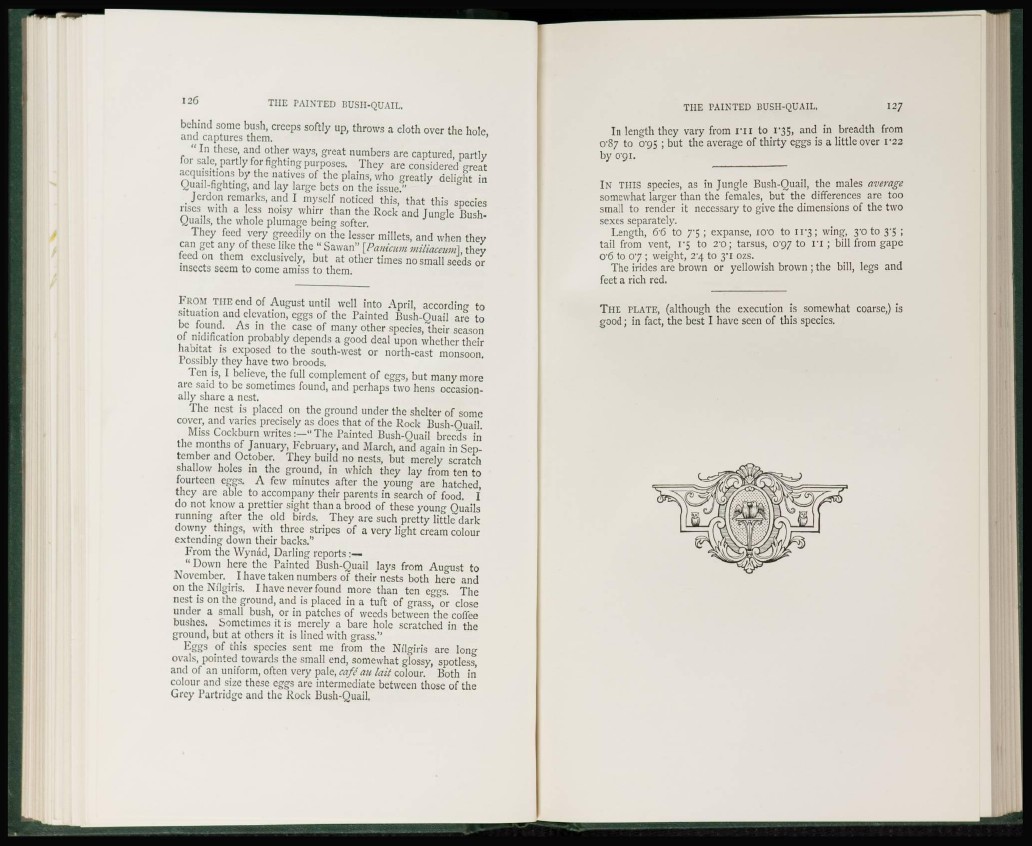
behind some bush, creeps softly up, throws a cloth over the hole,
and captures them.
" In these, and other ways, great numbers are captured, partly
for sale, partly for righting purposes. They are considered great
acquisitions by the natives of the plains, who greatly delight in
Quail-fighting, and lay large bets on the issue."
Jcrdon remarks, and I myself noticed this, that this species
rises with a less noisy whirr than the Rock and Jungle Bush-
Quails, the whole plumage being softer.
They feed very greedily on the lesser millets, and when they
can get any of these like the " Sawan" [Panicum miliaceum\ they
feed on them exclusively, but at other times no small seeds or
insects seem to come amiss to them.
FROM THE end of August until well into April, according to
situation and elevation, eggs of the Painted Bush-Quail are to
be found. As in the case of many other species, their season
of nidification probably depends a good deal upon whether their
habitat is exposed to the south-west or north-cast monsoon.
Possibly they have two broods.
Ten is, I believe, the full complement of eggs, but many more
arc said to be sometimes found, and perhaps two hens occasionally
share a nest.
The nest is placed on the ground under the shelter of some
cover, and varies precisely as docs that of the Rock Bush-Quail.
Miss Cockburn writes:—"The Painted Bush-Quail breeds in
the months of January, February, and March, and again in September
and October. They build no nests, but merely scratch
shallow holes in the ground, in which they lay from ten to
fourteen eggs. A few minutes after the young are hatched,
they are able to accompany their parents in search of food. I
do not know a prettier sight than a brood of these young Quails
running after the old birds. They are such pretty little dark
downy things, with three stripes of a very light cream colour
extending down their backs."
From the Wynad, Darling reports :—
" Down here the Painted Bush-Quail lays from August to
November. I have taken numbers of their nests both here and
on the Nilgiris. I have never found more than ten eggs. The
nest is on the ground, and is placed in a tuft of grass, or close
under a small bush, or in patches of weeds between the coffee
bushes. Sometimes it is merely a bare hole scratched in the
ground, but at others it is lined with grass."
Eggs of this species sent me from the Nilgiris are long
ovals,' pointed towards the small end, somewhat glossy, spotless,
and of an uniform, often very pale, cafe'an lait colour. Both in
colour and size these eggs are intermediate between those of the
Grey Partridge and the Rock Bush-Quail.
In length they vary from r u to 1-35, and in breadth from
0-87 to 0-95 ; but the average of thirty eggs is a little over i - 2 2
by 0"9i.
IN THIS species, as in Jungle Bush-Quail, the males average
somewhat larger than the females, but the differences are too
small to render it necessary to give the dimensions of the two
sexes separately.
Length, &6 to 7'5 ; expanse, LO'O to 11-3; wing, 3-0 to 3-5 ;
tail from vent, 1-5 to 2'0; tarsus, 097 to I T ; bill from gape
0'6 to 07 ; weight, 2'4 to 3*1 ozs.
The irides are brown or yellowish brown ; the bill, legs and
feet a rich red.
T H E PLATE, (although the execution is somewhat coarse,) is
good; in fact, the best I have seen of this species.